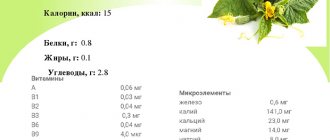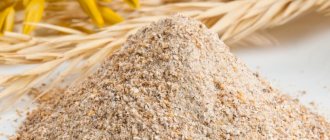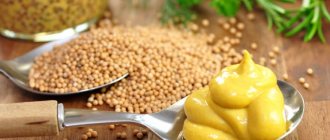Beneficial features
The beneficial properties of lettuce leaves are in their content of many minerals: potassium, calcium, copper, zinc, phosphorus, iron. In addition, they are rich in antioxidant vitamins, B vitamins, contain organic acids and enzymes, and carotene.
The kilocalories in 100 g of salad are negligible - 12-16, which makes it an indispensable product in dietary nutrition. But this fact is far from the only value of this product. This vitamin culture helps normalize the functioning of the digestive tract, genitourinary, nervous and immune systems.
It is enough to eat just one serving of salad a day, seasoned with olive oil, to reduce the risk of heart and vascular diseases by almost 50%. In addition, lettuce leaves are also used in folk medicine to treat headaches in weather-sensitive people.
They are also used to cleanse the blood and prevent atherosclerosis. Infusions of lettuce leaves are used as an expectorant for coughs and as a diuretic for swelling and cystitis.
But, like every product, salad greens also have their own restrictions on consumption.
[advertising]
Preparing lettuce for the winter
This product has a very wide spectrum of action.
It affects most organs and systems. Regular consumption of 3-4 leaves per day can significantly improve your health and overall well-being. What are the benefits of lettuce leaves for the human body:
- They have a beneficial effect on the functioning of the brain and are natural stimulators of cell function. They are often consumed instead of chocolate during increased mental stress;
- They have a calming effect and, when used regularly, relieve insomnia;
- Improve the functioning of the heart and blood vessels - reduce cholesterol levels in the blood, reduce the risk of heart attacks, strokes and other diseases;
- Due to its antioxidant properties, regular inclusion of green lettuce leaves in the diet is an excellent anti-cancer prevention and protection against the destructive effects of free radicals;
- Greens are used in folk medicine for gastritis, pancreatitis, and heartburn. It improves digestion and helps absorb nutrients;
- The vitamin complex has a positive effect on the body's defenses and improves immunity. Salad is recommended to be used for colds as an aid;
- Lettuce leaves help maintain healthy skin and hair. Vitamin A and potassium have this effect;
- Due to its high magnesium content, greens strengthen the nervous system and prevent the occurrence of nervous disorders;
- The expectorant and wound-healing properties of the plant help remove mucus from the bronchi and relieve cough;
- Fresh juice of this plant improves blood composition and stabilizes sugar levels. It is useful to use for anemia;
- During high physical activity, greens help maintain muscle tone and increase endurance;
- The inclusion of lettuce leaves in the diet of expectant mothers promotes the proper formation of the fetus. Thanks to vitamin B9, the likelihood of premature birth and miscarriage is reduced, and the baby develops without defects;
- Consumption during lactation increases the amount of milk in the mother and improves its quality;
- Vitamins and minerals have a beneficial effect on men's health. In representatives of the stronger sex, testosterone production increases. As a result, the quantity and quality of sperm improves, and the likelihood of impotence is noticeably reduced;
- Eating lettuce is also beneficial for women. It stabilizes hormonal levels, which is especially important during menopause.
Salad greens are included in many weight loss diets. It has a very low calorie content (15-25 kcal per 100 g) and provides a feeling of fullness for a long time. It is added to other dishes.
Lettuce leaves have also found application in cosmetology. Using it as an ingredient, you can prepare excellent facial and hair care products.
The most common recipes:
- A mask for toning aging skin will help restore its former elasticity and tighten the oval of the face. To prepare it, knead and chop several sheets to make 3-5 tbsp. spoons of raw materials. Then it is mixed with 2 tbsp. spoons of oil (corn or olive) and 2 teaspoons of lemon juice. The resulting paste is applied to a previously cleansed face for about 20 minutes.
- A mixture of 5-7 crushed leaves and 3 tbsp will get rid of peeling. spoons of cream. The procedure should last 15 minutes.
- For dandruff, use a mask of salad greens and burdock oil. It is applied to the roots, insulated and left for 30 minutes.
Such compositions perfectly nourish the skin, making it soft and velvety. And the hair gains vitality and shine.
Leaf lettuce - wavy, lush plates that have a bland taste, elastic to the touch, but quickly wither. Therefore, fresh leaves are added to salads just before consumption. It is not recommended to store lettuce for a long time;
Head lettuce. Wavy elastic leaves form dense light green heads.
There are various varieties of lettuce on sale, differing in interesting shades and shapes. In the retail chain, the plant is sometimes sold as Iceberg lettuce. The Italian analogue “Radichie” is considered the most delicious, with a characteristic slight bitterness. The French variety “Batavnya” has a piquant taste. For a long time it was believed that only seed oil was beneficial.
Infusions and juices made from lettuce leaves have healing beneficial properties. For many years, these remedies were the main options for combating diseases. Traditional recipes are still useful and relevant.
Infusion
For some diseases, infusions from seeds or leaves of lettuce are used; they are necessary for such purposes as:
- To reduce cough, it is useful to drink an infusion of leaves. To prepare a portion of the infusion, grind 20 g of fresh leaves and pour a glass of boiling water. Leave for about 1.5-2 hours and then filter. It is useful to take 50 ml 3 times throughout the day;
- to get rid of insomnia, infuse 20 g of crushed leaves in boiling water (250 ml). Leave for 25-30 minutes and filter. Leaf infusion (approximately 100 ml) is useful to drink before bed;
- To combat cystitis, infuse 20 g of finely chopped leaves in boiling water (250 ml). After 2 hours, filter the infusion. It is useful to drink 100 ml 2 times a day.
Water infusions have a gentle effect on the human body, maintaining its healthy tone.
The benefits of freshly prepared juices are undeniable, but storing the product for a long time and subjecting it to heat treatment is harmful.
| Indications | Ingredients | Methods of application |
| Anemia | 100 ml each fresh carrot and asparagus juices 50 ml lettuce leaf juice | 125 ml 2 times a day for 2 weeks |
| Periodontal disease, bleeding gums | freshly prepared juice | rinse your mouth for about 30 seconds four times a day |
| To normalize sleep | 25 drops of juice are dissolved in 100 ml of water | 3 times a day for 2 weeks |
| Normalization of lactation | 50 ml salad juice 100 ml carrot juice | in the morning after meals for 1 week |
| Rickets | 50 ml each turnip juice, lettuce leaves 20 ml dandelion juice | use 1 tbsp for 60 days. l 3 times a day |
Important! When preparing juices, it is not recommended to add salt, sugar, or various spices.
https://www.youtube.com/watch?v=Iesbx0nWvlw
The popularity of lettuce is explained not only by its rich vitamin content. Juicy greens are great for decorating dishes. The leaves complement the taste well not only in fresh salads, but also in appetizers, sauces, soups, meat and fish dishes.
As an additional ingredient in salads, lettuce goes well with eggs, cucumbers, meat, and other types of greens and vegetables.
As an independent dish, a salad of finely torn lettuce leaves is served on the table, then seasoned with vegetable oil, mustard, onion, and garlic are added. Salt to taste, sprinkle with lemon juice, vinegar, and season with finely chopped dill and parsley.
Advice! When preparing salads, lettuce leaves are usually not cut, but simply torn casually with your hands. It is believed that more vitamins are preserved this way.
Lettuce leaf puree soup is very healthy and popular as a first course. And boiled heads of cabbage serve quite well as a side dish for meat and fish dishes.
Lettuce oil is extracted from the seeds using the cold pressing method. The benefit of the oil is to restore the liver and improve the condition of the skin. Use the product both externally and internally for the following purposes:
- To normalize sleep, it is useful to drink 2 tbsp. l an hour before bedtime. To restore the nervous system, it is useful to take 3 tsp during the day;
- During massages, lettuce oil is used to normalize the performance of muscles and ligaments;
- masks are useful for nourishing aging and dry skin.
The product is not considered a medicine, but it helps fight insomnia and depression.
To create juice, it is beneficial to use dark green leaves rather than pale ones. A rich color indicates a high chlorophyll content.
Fresh leaves are used for cooking, since wilted leaves contain less vitamins and microelements. Lettuce salad is popular as an independent dish (before eating the main meal), which helps increase appetite. To obtain a pleasant taste, it is advisable to include no more than three types of greens in the salad.
For a salad to justify its nutritional value, you need to carefully inspect the greens before purchasing. The following recommendations must be followed:
- There should be no damage or traces of mucus on the stems. A yellowish tint means the product has a long shelf life;
- the leaves should have a rich green color and be elastic, not limp;
- Depending on the variety, salads have different shades - from light green to brown and red.
If the salad is not used immediately, then it is stored in the refrigerator, but no more than 12 hours. The leaves are pre-washed and dried (shaken off, but not squeezed). Then they are placed in a special container.
The healing properties of the leaves of this plant have been known since ancient times. Folic acid and pectin improve digestion, help cleanse the body of bad cholesterol, fight the development of atherosclerosis, strengthen the heart, and normalize the functioning of the human reproductive system.
The energy value of lettuce leaves is 14 kcal per 100 g. They are used in the fight against excess weight and obesity.
Diabetes mellitus is considered a common cause of excess weight. Vitamin PP (niacin, vitamin B3, nicotinic acid) is present in the leaves and enhances the effect of the hormone insulin, reduces blood sugar levels. Vitamin P (citrine) strengthens the walls of blood vessels and reduces their fragility.
Diabetics can eat lettuce without restrictions. Moreover, the healing effect of the plant on the human nervous system is due to the glycoside lactucin included in its composition. This substance lowers blood pressure, has a calming, anti-anxiety effect, and normalizes sleep.
For gastritis
Types of salads
Until a few years ago, we grew only one type of this vegetable - lettuce, a plant with curly green leaves.
Today, the variety of lettuce in our beds has increased significantly - from leaf crops to cabbage greens. By the way, lettuce has many varieties that come in different colors and shapes.
This is the so-called Red Lettuce - Lollo Rosso , which is so popular among gardeners. There are also lollo biond, frillis and others. Every summer I grow several types of lettuce, the greens of which I include in the family diet almost all summer. I'll tell you about some.
Arugula
Italians love this salad very much; I also like the nutty and slightly peppery taste of its leaves, which look like dandelion leaves.
All season long I add arugula to all vegetable salads, I especially like its combination with tomatoes, cheese and garlic.
Roman lettuce (romaine, romaine)
Without this salad, Caesar cannot be prepared. It consists of loose oval heads of cabbage, the leaves of which are slightly spicy in taste, crispy, but after heat treatment they stop crunching, so I prefer to eat it raw.
I usually use olive oil as a dressing, but sometimes I prepare garlic-curd dressing, which goes perfectly with this type of salad.
Radicchio (red chicory)
Its leaves are collected in small heads, their color can be different - white-pink, dark red, dark purple.
Red chicory has a slightly bitter taste and can be mixed with other types of salads. Or, to remove bitterness, soak in boiling water for a few seconds. It is recommended to season it with fruit juices, mayonnaise or honey sauce. This type of salad goes well with meat dishes and fruits.
Chicory salad
The closest “relative” of red chicory is salad chicory. Its pale green or yellowish leaves are formed into oblong heads and are shaped like small boats.
These “boats” are often used as “plates” on which cheese and herbs are served with curd or creamy dressing.
Iceberg (ice salad)
In appearance it resembles small light green heads of cabbage.
It is crunchy, has a neutral taste and goes well with any vegetables, herbs and dressings.
Watercress
Its small leaves are beautiful and tasty, both fresh and in casseroles and omelettes.
It goes well with all vegetables in salads and with any dressings.
The use of lettuce in home cosmetology
Recipes for home cosmetology will always be useful and in demand. After all, fresh products are used to prepare masks, decoctions, and creams, and therefore such cosmetics bring more benefits than ready-made factory-made creams.
To stop hair loss, rub the juice of lettuce leaves mixed with honey into the scalp. This composition also helps fight dandruff.
Masks with crushed lettuce leaves are suitable for various purposes. To prepare, place all ingredients into a blender and blend for 1-2 minutes. The mixture is kept in the refrigerator for 5 minutes and applied to cleansed skin. Its benefits are as follows:
- to remove oily shine from the skin, apply a mask of 1 tsp. grated lettuce leaves mixed with finely grated half a cucumber, 1 raw egg white. Add a teaspoon of lemon juice and finely chopped fresh mint;
- To restore the tone of aging skin, a mask of 2 tbsp is useful. l grated leaves, a tablespoon of full-fat sour cream and a couple of drops of olive oil;
- An excellent remedy for restoring skin after sunburn. Mix 2 tbsp. l mashed leaves and a spoonful of sour cream/kefir. This remedy is important on vacation, when you are near a body of water and the sun’s rays have a negative effect on the skin.
Attention! When applying masks to the face, the area around the eyes should not be affected. Keep the mixture for 10 minutes and rinse with water.
Face masks
Recipe with a softening effect for the skin of the hands and face:
- Chop lettuce leaves.
- For 1 tbsp. l. add 1 tsp to the mixture. corn oil and 2-3 drops of lemon juice.
- Take 2 tbsp. l. the resulting slurry, mix with 1 tbsp. l. sour cream.
- After applying to the skin, leave for 15 minutes, rinse with warm water.
Option that increases the elasticity of the epidermis:
- Mix 3 tbsp. l. salad pulp, 1 tbsp. l. olive oil, 1 tsp. lemon juice.
- Leave on skin for 20 minutes.
To remove peeling:
- Grind 8 leaves with 3 tbsp. l. sour cream or yogurt.
- Apply a thin layer and leave for 15 minutes.
Anti-dandruff mask
Burdock oil is good for hair, it strengthens it and helps get rid of dandruff:
- Grind the fox lettuce, add 4-5 drops of burdock oil.
- Apply to scalp, massaging lightly.
- Wash off after 20 minutes.
Recent comments
- Nadezhda on the post For those with a sweet tooth: recipes for homemade sweets
- Mirina on Sweet tooth: recipes for homemade sweets
- Elena on Sweet tooth: recipes for homemade sweets
- Alexander on Sweet tooth: recipes for homemade sweets
- Tramp to the post For those with a sweet tooth: recipes for homemade sweets
Harm of lettuce:
If salad is present in the diet in moderation, then it is absolutely harmless and the benefits of green leafy salad will be obvious to you, and there is no harm from green salad. If you consume this vegetable more actively, then you need to take into account that salad, like all foods rich in fiber, can cause such unpleasant reactions in the body as flatulence (excessive gas formation) and intestinal upset.
Salad greens contain significant amounts of oxalic acid, which is harmful for diseases of the bladder and kidneys.
In addition, eating salad is contraindicated:
- for urolithiasis,
- for acute gastrointestinal diseases (enterocolitis, colitis),
- for gout,
- for hepatitis
With extreme caution, vegetables should be included in the diet of patients suffering from asthma and tuberculosis.
Share the article with your friends on social networks!
More on the same topic:
Comments (0)
Contraindications
The benefits of the vegetable are undeniable. However, if used incorrectly, it can be harmful. If you consume it in too large quantities, gas formation in the intestines may increase. Contraindications for consuming vegetables are kidney stones, urolithiasis, gout. Consumption will cause harm to people suffering from chronic colitis, enterocolitis in the acute stage. Contraindications – taking indirect anticoagulants. Green leaves will cause harm in case of tuberculosis and bronchial asthma. The harm and benefits of salad are relative concepts. The harm of lettuce for sick people can be reduced by consuming it in reasonable quantities.
Lettuce: health benefits and harms, beneficial properties and contraindications
Let's talk in more detail about the benefits that greens have on our health:
- As mentioned above, lettuce leaves contain a colossal amount of useful elements. For example, vitamins of groups A, B, C, E, K, PP - their intake has a positive effect on the condition of bones, hair and nails, as well as skin. And vitamin E is simply necessary for women's health and the normal functioning of the female reproductive system.
- As for microelements, the salad also contains enough of them: manganese, potassium, boron, iron, copper, phosphorus. All these minerals also improve the health of hair, nails, teeth and epithelium.
- In addition, the manganese in the composition promotes better absorption of vitamins obtained from food, and magnesium strengthens the heart muscle and blood vessels.
- You should also eat salad because it reduces high cholesterol, improves blood circulation in the body, stimulates active nutrition of all tissues and organs, and is a prevention of many heart diseases, as well as diseases associated with the digestive system.
- Regular consumption of the plant reduces the risk of varicose veins and blood clots.
- The antioxidants contained in lettuce crops help the body fight the aging process and prevent the appearance of facial wrinkles and folds.
- The vegetable contains folic acids, which have a beneficial effect on the health of the reproductive system of both men and women.
- Ascorbic acid, which green leaves are rich in, perfectly strengthens the immune system and helps the body fight infections and diseases.
- The green plant facilitates the digestion of food and helps the body more actively absorb fats.
- Vegetables, due to their properties, can serve as a prevention of cancer.
- The advantage of the plant is that it can be eaten by people with diabetes, since the salad normalizes blood sugar levels.
- The salad will also be useful for weight loss. Firstly, you can eat this vegetable in large quantities and not be afraid to gain weight, because one hundred grams of lettuce leaves contain less than thirty calories and almost no fat! Secondly, salad speeds up metabolism and triggers the breakdown of lipids in the body, which helps to quickly get rid of extra pounds.
- It would not be amiss to mention the ability of lettuce leaves to reduce appetite. Add this product to your meals and you won’t notice how you eat less and get fewer calories.
- Lettuce leaves have a sedative effect, calm the nervous system, relieve anxiety and can help fight depression or sleep disorders.
Vegetables are rich in mineral elements and vitamins. Its chemical composition helps strengthen the immune system and helps in the treatment of many diseases. The plant is used in cosmetology, dietetics, and folk medicine.
Benefit
Experts believe that regular consumption of lettuce, due to its beneficial properties, can prevent the development of Alzheimer’s disease, strengthen the skeleton and bone tissue, improve the digestive process due to its high fiber content, improve the condition of teeth, skin, mucous membranes of the body, and compensate for the deficiency of vitamins and minerals. .
Rules for preparing salads
Many people know only one rule, the essence of which is that after washing the greens cannot be cut with a knife, but you just need to tear them into pieces with your hands. Thanks to this procedure, more vitamins are preserved. A few more simple but very important rules should be noted:
- 1) it is necessary to season a dish that contains lettuce leaves right before starting a meal, otherwise the taste characteristics and appearance will be lost;
- You shouldn’t add all kinds of greens to your lettuce salad; one or two will be enough to enjoy the taste and benefit from the meal.
Leaf lettuce - what do you need to know about this plant?
This green plant is probably familiar to anyone who has ever eaten sandwiches or Greek salad.
Or just strolling through the produce section at the supermarket and seeing leaves that are a pleasant green color. The homeland of salad crops is unknown, but we can say for sure that this plant was first eaten in Mediterranean countries. The ancient Greeks and Romans loved to decorate dishes with salad; they also ate the vegetable in the Middle Kingdom, and several hundred years ago, salad crops began to be cultivated in Europe, and then in Russia.
The plant, by the way, is now grown in almost all latitudes, even in cold Siberia, since the lettuce is extremely unpretentious and can tolerate cool weather.
There are a great many varieties of lettuce: iceberg, Chinese cabbage (which looks like a head of cabbage), batavia, leaf lettuce... Arugula and spinach are also varieties of lettuce.
The advantage of the salad is not only its rich taste variety, but also its vitamin composition and low calorie content. The salad will thus help maintain normal health and diversify your diet.
Speaking about the properties of salad, we cannot mention contraindications, as well as possible harm to the product due to the presence of a large amount of oxalic acid in the composition.
- The plant is not recommended for use by people suffering from urolithiasis, as well as other diseases of the kidneys and urinary tract.
- Salad is contraindicated during acute diseases of the gastrointestinal tract (colitis, entercolitis).
- The vegetable should not be eaten by people with gout or hepatitis.
- It is worth considering that greens have a slight laxative effect, which may be a disadvantage for some people.
- People with problems with the respiratory system (for example, bronchial asthma) should eat salad with caution. For tuberculosis, the vegetable may also be contraindicated.
Carbohydrates, g: 1. Information that lettuce was eaten is found in documents describing the existence of the ancient Roman Empire; before that time, lettuce was grown for its seeds, from which oil was squeezed out. The exact geographical place of origin of the first types of lettuce has not been historically established.
Lettuce has many varieties, the most common, leaf lettuce, has long, tender shoots in the shape of oak leaves, light green in color. Lettuce leaves are juicy, crunchy, with a fresh smell, and can vary in shape and quantity located on one root or head.
Calorie content of salad The calorie content of salad is 12 kcal per gram of product.
The salad is saturated with a large number of macro and microelements. Beneficial properties Salad contains nutrients in huge quantities, therefore it is considered one of the most healthy foods.
It’s not for nothing that celebrities such as Alessandra Ambrosio, Blake Lively, Natalie Portman, Nicole Kidman, Demi Moore, Valeria, Anna Kovalchuk, Irina Bezrukova and others cannot imagine their day without green salads, nutritious smoothies, vegetable stews and healthy soups, believing that this is the surest path to an elegant figure, beautiful skin and a good mood.
The composition of the multivitamin culture includes dietary fiber - soluble and insoluble. The alkaloid lactucin gives the leaves a slight bitterness. Beta-carotene and lutein have the ability at the cellular level to prevent the destruction of the body.
Folic acid has a positive effect on enhancing reproductive function. Light metal salts stabilize the functioning of many organs and participate in mineral metabolism processes.
Sulfur in combination with silicon and phosphorus strengthens the epithelium, improves the condition of the hair and nails.
Iodine and carotenoids prevent the development of Alzheimer's disease and help restore visual function. How many calories in g.
One gram of crunchy leaves contains only kcal. They do not have a pronounced taste because they contain very small amounts of aromatic substances. The juicy and fleshy leaves contain magnesium, which can quickly strengthen the nervous system, restore muscle tissue, and prevent mental attacks and prolonged depression.
A few leaves in your daily diet will help speed up fat and lipid metabolism, improve the functioning of the entire gastrointestinal tract, and relieve heartburn. And for bone mass, as scientists have found, it is simply necessary. The calcium included in the composition is absorbed much easier and faster than a similar component from fermented milk products. Vitamin C has powerful antioxidant properties.
In combination with tocopherols, it creates a reliable shield against negative manifestations of the external environment - toxins, radiation, exhaust gases.
The plant remarkably supplies the brain with nutrients, enriches it with oxygen, which affects the increase in endurance, improvement of mood, sensitivity, and performance of the body.
During prolonged colds and viral diseases, the annual will provide the body with vitamin C. It will promote better coughing up of mucus, as it can thin the mucus in the bronchi.
External use of lettuce helps get rid of migraines. Doctors advise enriching their diet during spring vitamin deficiency. Tip: Want to prepare lettuce for future use? Freeze it as a puree or pickle it.
In folk medicine, juice from lettuce leaves helps with peptic ulcers, arthritis, rheumatism, is important for strengthening the walls of blood vessels, as well as with blood pressure. Prescribed for diabetes, insomnia, and also to increase the amount of breast milk when breastfeeding a baby.
Beneficial properties for men The rich chemical composition of the Asteraceae plant promotes the production of testosterone in the male body.
A high content of the hormone will protect a man from problems with potency, ensure active blood flow to the genital organ, and will contribute to a sufficient amount of sperm produced.
The presence of B vitamins in the salad has a beneficial effect on strengthening the entire male body. Their deficiency provokes insomnia, irritability, and leads to rapid fatigue and numbness of the limbs.
The asteraceous plant promotes hair growth and is a natural remedy for the prevention of baldness and baldness. Tinctures penetrate deeply into the epidermis, nourish hair roots, and restore damaged cells.
Benefits for women Thanks to the presence of folic acid, the healing annual has a beneficial effect on the female body - it regulates hormonal balance, alleviates the condition during painful menstruation, reduces the risk of developing breast and ovarian cancer, and smoothes out unpleasant symptoms during menopause.
The garden plant must be included in the diet of expectant mothers for the full intrauterine development of the baby. How is it good for the face? Vitamin mixtures with the addition of crushed leaves saturate the skin with life-giving moisture, making it velvety, elastic, and young. Is your face peeling or losing its fresh look? Prepare a mixture of mashed lettuce leaves and 3 tbsp.
The duration of the mask is 15 minutes. Do you want to improve skin elasticity? The composition from Art. Apply to face for 20 minutes. A mask of lettuce leaves with the addition of a few drops of burdock oil will strengthen your curls and get rid of dandruff. Why is this happening? Vegetables are rich in fiber, which helps: improve digestion;.
Discuss Edit article From the point of view of experts, lettuce is one of the most ancient, frequently eaten and healthiest plants in the world. This product is not only nutritious, but also has healing properties. Among all low-calorie foods, salad comes first.
You definitely need to be careful about your diet if you want to live a long time, always have a good mood and a lot of energy. The human body especially needs fruits, vegetables and herbs. In particular, lettuce leaves have important properties.
Sulfur in combination with silicon and phosphorus strengthens the epithelium, improves the condition of the hair and nails. Iodine and carotenoids prevent the development of Alzheimer's disease and help restore visual function. How many calories in g.
Minerals Description Salad is a fairly popular food product that is distributed almost all over the world. Growing the plant is very simple and can be done in your garden or at home in a pot on the windowsill. The history of lettuce goes back thousands of years and was initially perceived as an ordinary weed.
Systematic intake of salad will saturate the human body with essential organic acids, vitamins, and mineral compounds. The benefits of the plant have been thoroughly studied, but is there any harm from eating lettuce? Let's consider the main aspects in order. Composition of leaf lettuce The benefits of juicy lettuce are determined by the accumulation of substances that are included in the chemical list.
The salad contains a lot of thiamine, ascorbic acid, alpha-tocopherol, and pyridoxine. The plant also includes riboflavin, pantothenic acid, vitamins K, PP, B9. The value lies in the presence of macro- and microelements. These include sodium, potassium, boron, copper, calcium, silicon, phosphorus. The plant is not deprived of aluminum, beryllium, manganese, iron, iodine, and chlorine. The culture contains soluble and insoluble dietary fiber, alkaloid compounds, beta-carotene, and lutein.
Properties of lettuce
Lettuce for immunity
The product is rich in nutrients, it contains a whole range of important vitamins and antioxidants that renew the body. This nourishment helps strengthen the immune system. Beta-carotene, ascorbic acid, and folic acid stand out especially. An abundant supply of these substances awakens the body's defenses and improves blood composition. By regularly eating arugula and other leafy vegetables, your overall tone increases.
Nutrients of salad
Due to the high content of vitamin K, normal blood clotting is maintained. The product can also replenish iron deficiency, which is definitely useful for anemia. It is impossible to overlook the presence of potassium in the composition; this useful substance helps normalize blood pressure. It is important that the salad contains magnesium, which nourishes hair and nails. If you constantly eat leafy vegetables in sufficient quantities, the content of phosphorus and iodine in the body will remain at normal levels, which means that the brain will work correctly and productively until old age. It has been revealed that salad, that is, lactucin in its composition, has a positive effect on the nervous system and helps normalize sleep. The visual organ also receives support, as zeaxanthin and lutein enter the body.
Salad for women
Every representative of the fair sex is a potential mother, so all ladies should know that an infusion of lettuce seeds helps to enhance lactation and improve the quality of breast milk. Folic acid has a positive effect on the women's body, helping to establish balance in the hormonal system, alleviate menstruation, reduce the susceptibility to cancer in the ovaries and breasts, and alleviate discomfort during the difficult period of menopause. Leafy vegetables are good for expectant mothers to eat so that the fetus develops properly. You can make homemade hair and face masks from the salad; in this case, you need to puree the product and mix it with cosmetic oil or dairy products. Among other things, we recommend taking a warm bath with water in which large quantities of lettuce were soaked - the procedure helps improve the condition of the skin of the entire body.
Possible harm of lettuce
Before including lettuce on the menu, the benefits and harms of the product for the body of a particular person must be adequately assessed.
In one case, leafy vegetables provide a healing effect, and in another they provoke a deterioration in the body’s functioning. The product may cause negative consequences if at least one of the following disorders is diagnosed: gout, urolithiasis, acute enterocolitis, chronic colitis. Due to the high concentration of oxalic acid in the composition, you should avoid or minimize the consumption of salad in case of kidney failure. The product should not be eaten if you have hepatitis. You should eat salad with caution if you have tuberculosis and asthma. When there is an acid-base imbalance in the body, called phosphaturia, the product is contraindicated. If you are prone to flatulence, then salad is not suitable for you. Lettuce: a light vitamin product for good health and a beautiful figure
The benefits of lettuce: cosmetic recipes
Women of different ages have long been using green salad to maintain the beauty of their skin and curls. The beneficial effects of lettuce on the face are as follows. It is useful to add crushed leaves to ordinary cosmetic masks that many women use to saturate the skin with life-giving moisture. Over time, the appearance will undergo slight changes: the skin will become more elastic and velvety.
If a woman’s face is no longer so fresh, and peeling processes begin, the following composition will help:
- grind seven or ten lettuce leaves;
- add three tablespoons of cream, yogurt or sour cream.
Mix all ingredients well.
The time it takes for the mask to work is a quarter of an hour.
You should remember the benefits of lettuce when you want to increase skin elasticity. The composition is prepared as follows:
- three to four tablespoons of pulp from the leaves;
- a teaspoon of lemon juice;
- a tablespoon of olive or corn oil.
Mix all ingredients thoroughly.
This mask should remain on your face for about twenty minutes.







